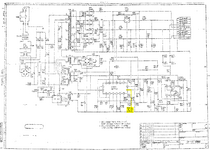I actually wish the POT in my SONY maxed out at 7V so I could pull it down to where the voltage at the motherboard would be 5.05v or there about. My max "no load" voltage, as set via the blue POT, is 5.49v, and you can see that on my
spreadsheet here (created when I did the Baby Face PSU review video). The implications of that is that if you have the stock main wiring harness and power-hungry upgrades installed, there's a large voltage drop across that harness, and you always end up with 4.90v or less when measured at the motherboard.
However, your stated "7.0v" is quite high.
You said dropping the voltage via Blue POT brings the 12v line down to
10.45v, but what is the
5v rail voltage, measured at the motherboard, when the 12v rail is 10.45v?
I ask because if your 12v rail drops to 10.45v when you set the POT so the 5v rail measures 5.00V at the PSU (not at the motherboard), that's the wrong way to go about it. You always need to measure at the motherboard due to the large voltage drop across your main wiring harness. The more stock your motherboard, the less voltage drop it will be. But on my machines with upgrades, the voltage drop is always rather large. Or at least, it used to be. I now upgrade my main wiring harnesses in my SE and SE/30 machines using thick 16AWG wires, and you'll find links to RED and BLACK versions of those 16AWG wires in the lower right corner of the spreadsheet page ("SONY PSU" tab) I linked for you above.
You also need to verify
STABILITY of your PSU's voltage. For example, does it stay rock solid at 5.0 voltage or does your meter show fluctuations? A scope is far, far better to check stability than a meter because a meter often doesn't update but once every 200ms or so. The scope shows you ever little dip and spike over time.
I’ve never heard of the blue “RV251” POTs going bad, and I’m not saying yours is or out of spec either, but if you aren’t making any progress based on what I said above, you could desolder the POT and measure it out of circuit to see if it is indeed still a
1KΩ POT, as per the attached schematic.

